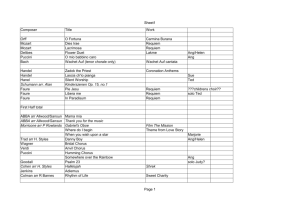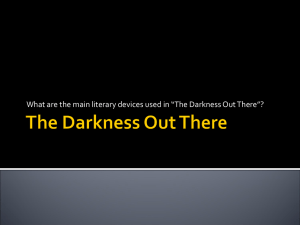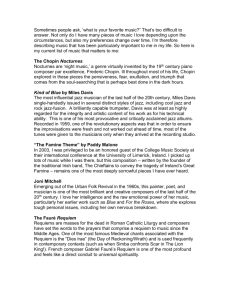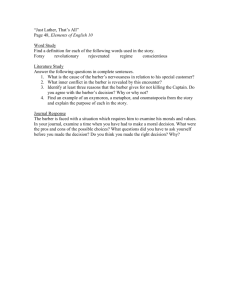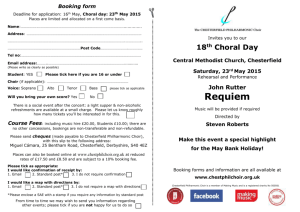Amy Balcomb (510035) Level 2 Composition
advertisement
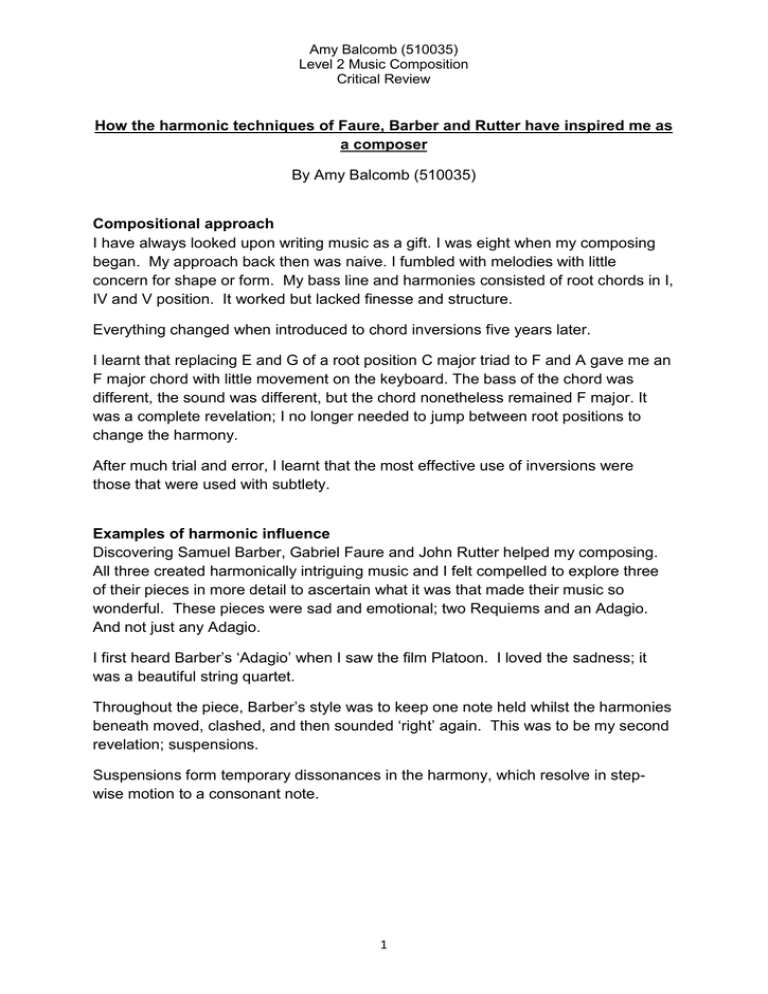
Amy Balcomb (510035) Level 2 Music Composition Critical Review How the harmonic techniques of Faure, Barber and Rutter have inspired me as a composer By Amy Balcomb (510035) Compositional approach I have always looked upon writing music as a gift. I was eight when my composing began. My approach back then was naive. I fumbled with melodies with little concern for shape or form. My bass line and harmonies consisted of root chords in I, IV and V position. It worked but lacked finesse and structure. Everything changed when introduced to chord inversions five years later. I learnt that replacing E and G of a root position C major triad to F and A gave me an F major chord with little movement on the keyboard. The bass of the chord was different, the sound was different, but the chord nonetheless remained F major. It was a complete revelation; I no longer needed to jump between root positions to change the harmony. After much trial and error, I learnt that the most effective use of inversions were those that were used with subtlety. Examples of harmonic influence Discovering Samuel Barber, Gabriel Faure and John Rutter helped my composing. All three created harmonically intriguing music and I felt compelled to explore three of their pieces in more detail to ascertain what it was that made their music so wonderful. These pieces were sad and emotional; two Requiems and an Adagio. And not just any Adagio. I first heard Barber’s ‘Adagio’ when I saw the film Platoon. I loved the sadness; it was a beautiful string quartet. Throughout the piece, Barber’s style was to keep one note held whilst the harmonies beneath moved, clashed, and then sounded ‘right’ again. This was to be my second revelation; suspensions. Suspensions form temporary dissonances in the harmony, which resolve in stepwise motion to a consonant note. 1 Amy Balcomb (510035) Level 2 Music Composition Critical Review This temporary dissonance was the ‘clash’ that I was hearing, a tense, dramatic effect that fascinated me: Samuel Barber’s ‘Adagio’ – Opening two bars The opening bars to the Adagio (above) demonstrate the surprise that Barber creates with his suspension in the first violin. Only when he resolves the B-flat anacrusis to the A-natural in bar 2 does he release the tension from IV (E-flat minor) to V (F major). 2 Amy Balcomb (510035) Level 2 Music Composition Critical Review Samuel Barber’s ‘Adagio’ – Opening four bars As we continue to follow Barber’s music through this first four-bar phrase, we see that he sustains beneath the 1st violin the harmony of chord V (F major), giving a rich harmonic foundation for the violin to explore tentatively the third, fourth and fifth degrees of the scale; it’s as though the melody isn’t completely confident about straying too far away. It is only on the second beat of bar 3 that Barber takes us to chord IV again but this time in the first inversion. The first of the 2nd violins extends it’s long, sustained F from bar 2, which creates a further suspension in the harmony before Barber moves us to Ab major in bar 4. With the very slow ‘molto adagio’ tempo, we hear each of these subtle harmonic movements, which amount to a complex, intricate progression that sounds simple and heart-wrenchingly beautiful. 3 Amy Balcomb (510035) Level 2 Music Composition Critical Review I felt the more I worked with suspensions the more I felt that they emphasised and strengthened the harmony. Amy Balcomb’s ‘Woodland Burial’ – Bars 5-8 Here, in this excerpt from my Assignment ‘Woodland Burial’, I use a 2-1 suspension; the G in the piano part on beats 1 & 2 of bar 8 is the temporary dissonance, which resolves to an F on beat 3. By using this technique, I created more emphasis to the descending major tonality modulation. With contrary motion between the melody line and bass part of the piano, this also strengthened the descending chord movement. Gabriel Faure’s ‘Requiem’ was a set text for my GCSE Music and it was my introduction to the requiem form, the musical setting of the Roman Catholic mass. 4 Amy Balcomb (510035) Level 2 Music Composition Critical Review The third movement, ‘Sanctus’, stood out. Upon closer study, I realised that its construction relied heavily upon inverted chords, which moved in rising arpeggiated patterns: Gabriel Faure’s ‘Requiem’ – Movement 3 ‘Sanctus’ – Bars 1-3 This pattern continues throughout the entire movement; in particular, Figures D - E demonstrates Faure’s skill at subtle yet highly effective harmonic development through the use of inversions: I wrote inverted chords into my third assignment ‘Idyll for Strings’: Gabriel Faure’s ‘Requiem’ – Movement 3 ‘Sanctus’ – Bars 34-36 (continued over page) 5 Amy Balcomb (510035) Level 2 Music Composition Critical Review Gabriel Faure’s ‘Requiem’ – Movement 3 ‘Sanctus’ – Bars 37-42) Within the space of eight bars, Faure moves us through some incredibly beautiful harmony: Bar 35 (Figure D): Bb minor – first inversion Bar 36: Bb minor on Gb Bar 37: Db major – second inversion Bar 38: Bb major diminished 7th, G minor, Bb7 – second inversion Bar 39: C7 – first inversion, Bb major 7 – second inversion Bar 40: Eb major – first inversion, Ab major 7 Bar 41: Eb major – second inversion with 3-2 suspension (Eb to D) Bar 42: Eb major Like Faure, the passage sounds incredibly simple and seamless, which in turn adds to its beauty, but the inverted chords allow for such smooth harmonic transition. 6 Amy Balcomb (510035) Level 2 Music Composition Critical Review Amy Balcomb’s ‘Idyll for Strings’ – Bars 16-18 I wrote inverted chords into my third assignment ‘Idyll for Strings’. Bar 17 centres around a first inversion B-flat major chord, which is followed sequentially by a first inversion A-minor chord. This enabled me to delay reaching the subdominant of Bflat major whilst making the harmonic structure more subtle. My introduction to John Rutter’s Requiem was as part of an Easter programme that I sang with the Oratorio at Wells Cathedral. The ‘Lux Aeterna’ was my favourite movement of the Requiem, and Rutter combines both inverted chords and suspensions throughout. The opening of the movement we hear a solo Bb in the bass/timpani, which is harmonically ambiguous; only in bar 3 does Rutter introduce us to a second inversion chord of the tonic, Eb major, in the first half of the bar before hinting at a Bb minor tonality with the Db-F for the second half: 7 Amy Balcomb (510035) Level 2 Music Composition Critical Review John Rutter’s Requiem – Movement 7 ‘Lux Aeterna’ – Bars 1-5 With the use of these inversions, Rutter still doesn’t root the piece harmonically until bar 25 at figure A, when we finally hear the tonic chord of Eb major, preceded by the perfect cadence formed by the dominant Bb7: John Rutter’s Requiem – Movement 7 ‘Lux Aeterna’ – Bars 24-25 8 Amy Balcomb (510035) Level 2 Music Composition Critical Review An example of one of Rutter’s subtle yet effective uses of suspension can be seen in bar 96 and 97. The music has reached A major by bar 96 and a perfect cadence is formed to return the piece temporarily to D major: John Rutter’s Requiem – Movement 7 ‘Lux Aeterna’ – Bars 94-97 The basses in bar 96 sing a G natural, creating a 4-3 suspension. It resolves in bar 97 to the F-sharp. The change of feel at Section C when the tempo drops from moderato to andante tranquillo is exquisite. John Rutter’s Requiem – Movement 7 ‘Lux Aeterna’ – Bars 94-97 In bar 40, we are in E-flat major. Rutter pauses the homophonic texture in the relative minor of C at bar 41 with the addition of the alto’s D for extra dissonance and tension: John Rutter’s ‘Requiem’ – Movement 7 ‘Lux Aerterna’ – Bars 38-41 John Rutter’s Requiem – Movement 7 ‘Lux Aeterna’ – Bars 38-41 9 Amy Balcomb (510035) Level 2 Music Composition Critical Review As he moves us into Section C, he resolves the tension by taking us to the dominant key of G major and in root position, too; it’s a definite consonant tonality that signals a new, final passage to the movement: John Rutter’s Requiem – Movement 7 ‘Lux Aeterna’ – Bars 42-43 The triplets create a similar feel to that of Faure’s ‘Sanctus’; they provide a light but distinct harmonic line. It also helps to keep the music driving forward beneath the long sustained vocal lines above. 10 Amy Balcomb (510035) Level 2 Music Composition Critical Review I, too, have used inverted chords, an example here from my ‘Woodland Burial’ assignment – it allowed ‘economy of movement’ within the harmony but also created a relaxed feel: Amy Balcomb’s ‘Woodland Burial’ – Bars 1-5 I wanted the opening harmony to stay as close to A-minor as possible and I achieved this by rooting the bass on A in bars 1-2 whilst the harmony of B-minor dim7 is still hinted at. In bar 3, I move through A-minor in the first half of the bar to the first inversion of E-minor. Bar 4 works through the first inversion of chord IV (D-minor) before taking us to chord V (E major), which forms a perfect cadence return to A minor in bar 5. 11 Amy Balcomb (510035) Level 2 Music Composition Critical Review The composers’ influences Faure could have attributed his Requiem to the deaths of his parents in the mid 1880s. Faure was quoted: ‘My Requiem wasn’t written for anything – for pleasure, if I may call it that!’. However, Wikipedia notes how similar Faure’s Requiem is to the structure of Brahms’s ‘German Requiem’ and to Mozart’s ‘Requiem’ (it shares the key of D minor). Thomas Larson comments in ‘The saddest music ever written’ that Barber may have been influenced by Schubert’s String Quartet in C Major when writing his quartet, the ‘Adagio’ forming the second movement. Many don’t know the impetus behind Barber’s piece. John Rutter’s influences are easier to establish, given in an interview about his Requiem. He cites the death of his father and Faure’s Requiem as the two impetuses to his piece. Rutter admired Faure’s flexibility of performance setting (church or concert hall). He liked Faure’s personal selection of texts; favourite sections were kept, whilst omitting less favoured parts such as the ‘Day of Judgement’, normally the second movement. Faure also broke with tradition adding the ‘In Paradisum’, normally found in the catholic burial service. Musical Context Gabriel Faure (1845 – 1924) was a French composer, organist, pianist and teacher who wrote his Requiem between 1887-1890. Around this time, his compositions varied from solo piano pieces, vocal and piano arrangements, to larger orchestral & choral works. The requiem is short - 35 minutes - has 7 movements and written for orchestra, organ, mixed chorus and two soloists. Performed in Latin it premiered in it’s first version in 1888. Faure only originally wrote 5 movements and added the ‘Offertorie’ and ‘Libera Me’ later on, premiering in 1893. Samuel Barber (1910-1981) was an American composer of orchestral, opera, choral and piano music. Arguably the most famous of his music was his ‘Adagio for Strings’, the second movement of his String Quartet, Op.11, written in 1936. Around this time, Barber was writing various music, including orchestral works, solo organ compositions and string pieces. 12 Amy Balcomb (510035) Level 2 Music Composition Critical Review The ‘Adagio’ was performed by NBC Symphony Orchestra under the direction of Arturo Toscanini in 1938, upon which he remarked ‘Semplice e bella’ – simple and beautiful. Barber wrote a choral arrangement of ‘Agnus Dei’ in 1967 using the music from the ‘Adagio’. Other arrangements have since been written; William Strickland’s ‘Solo Organ’ (1949), Lucien Cailliet’s ‘Clarinet Choir’ (1964) and John O’Reilly’s ‘Woodwind Band’ (1967). Barber’s ‘Adagio’ has been heard worldwide at many sad public occasions, including the announcements of President’s Franklin Roosevelt and J.F Kennedy’s deaths and played at the funeral of Princess Grace of Monaco. John Rutter (born 1945) is a British composer, conductor, editor, arranger and record producer, mainly of choral music. He is the only contemporary composer I have identified as an influence to my music. I have also met him at a singing master class where he conducted the Requiem. His Requiem consists of 7 movements for orchestra and chorus together with soprano solo, although the original version had 4 movements for chamber orchestra and chorus. Rutter has a combination of Latin and English texts. In conclusion, these three composers opened my eyes to how specific distinct harmonic techniques can be used, both to enhance a mood or feeling and/or to add emphasis to a harmonic progression. Suspensions form temporary tensions in the harmony and I will always be drawn to them because of their emphatic nature. Inversions are the antithesis and allow composers to progress their harmonies with subtlety. These two techniques will always be a part of my composition and I will forever be grateful to Faure, Barber and Rutter for showing me how it can be done. 13 Amy Balcomb (510035) Level 2 Music Composition Critical Review References: Websites: Larson, T. (Unknown). The Saddest Music Ever Written: The Story of Samuel Barber's 'Adagio for Strings'. Available: http://thomaslarson.com/publications/essaysand-memoirs/91-the-saddest-music-ever-written. Last accessed 29 January 2014. Lynch, M. (2009). Programme Notes - Barber 'Adagio for Strings'. Available: http://programnotes.wikia.com/wiki/Barber_-_Adagio_for_strings. Last accessed 30 January 2014. McKendrick, P. (2007). A Conductor's Analysis of Gabriel Faure's Requiem Op. 48. Available: http://scholarworks.gsu.edu/cgi/viewcontent.cgi?article=1001&context=music_theses . Last accessed 29/01/14 Rogers, R. (22/10/89). Choral society to open with Barber's Adagio. Available: http://newsok.com/choral-society-to-open-with-barbers-adagio/article/2287504. Last accessed 24/03/14. Rutter, J. (2010). John Rutter on the Requiem: YouTube video. Available: http://www.johnrutter.com/john-rutter-on-the-requiem-youtube-video-series/. Last accessed 12 March 2014. Rutter, J. (Unknown). John Rutter on the Requiem 1: Impulse and influence. Available: https://www.youtube.com/watch?v=WaHO72_mJzI. Last accessed 12 March 2014. Rutter, J. (Unknown). John Rutter on the Requiem 2: Liturgical settings. Available: https://www.youtube.com/watch?v=oxsl23yqdso. Last accessed 12 March 2014. Rutter, J. (Unknown). John Rutter on the Requiem 3: Form and structure. Available: https://www.youtube.com/watch?v=AoJ-ZeHa2w4. Last accessed 12 March 2014. Rutter, J. (Unknown). John Rutter on the Requiem 4: Conception and performance. Available: https://www.youtube.com/watch?v=ajwh7p7Xr50. Last accessed 12 March 2014. Unknown. (Unknown). Requiem. Available: http://en.wikipedia.org/wiki/Requiem. Last accessed 29/01/14. Unknown. (Unknown). Harmonic Structure. Available: http://en.wikipedia.org/wiki/Harmonic_structure. Last accessed 29 January 2014. Unknown. (Unknown). Adagio for Strings. Available: http://en.wikipedia.org/wiki/Adagio_for_strings. Last accessed 29 January 2014. 14 Amy Balcomb (510035) Level 2 Music Composition Critical Review Books: Barber, S (1939). Adagio for Strings - String Quartet Score. USA: G. Schirmer Ltd. Entire score. Faure, R (Unknown). Requiem, Op.48 - Vocal Score & Piano Reduction. London: Novello Publishing Ltd. Pgs 18-23. Larson, T (2010). The Saddest Music Ever Written - The Story of Samuel Barber's 'Adagio for Strings'. New York: Pegasus Books LLC. Entire book Rutter, J (1986). Requiem - Vocal Score and Piano Reduction. Oxford: Oxford University Press. Pgs 54-64 15

